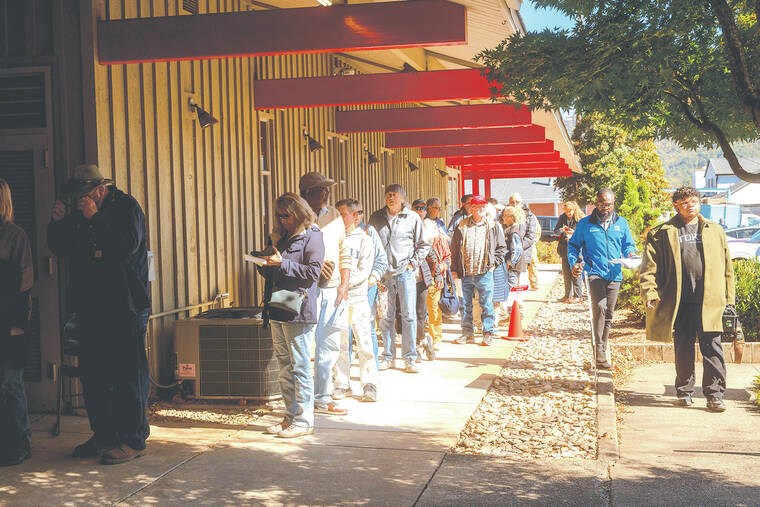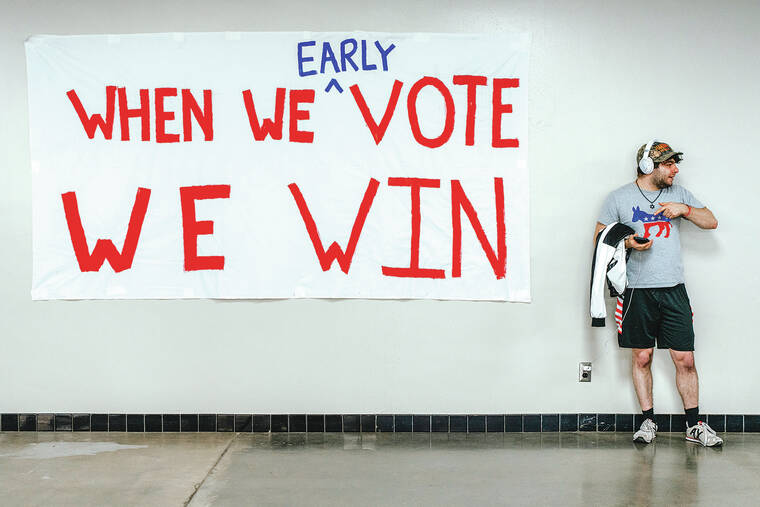With Election Day 2 weeks away, 17 million voters have already cast a ballot



With two weeks until Election Day, more than 17 million people have already cast their ballots, the clearest sign yet that voting habits were forever changed by the coronavirus pandemic and that early voting has become a permanent feature of the American democratic process.
While many people cast a mail-in ballot or voted early in the 2020 election out of necessity amid a dangerous pandemic, a lot of voters are choosing to vote early in this election, too. Some are taking advantage of new laws that expanded early voting options; others simply favor the process that exploded in popularity four years ago.
ADVERTISING
Many states have set records for the first day of early voting. On Thursday, more than 353,000 ballots were cast in North Carolina, a record for the swing state still reeling from Hurricane Helene. On Friday, nearly 177,000 voters cast a ballot in Louisiana, a record for the deep-red state.
The shift has been starkest in Georgia, where voters have set a daily record for in-person early voting nearly every day since polls opened last Tuesday. More than 1.5 million voters have already cast an early ballot in the critical battleground state.
The persistent preference of many Americans to vote early — both by mail and in person — comes after the 2020 election prompted a sea change in voting habits for the country. With many fearful of voting in person during the pandemic, 65.6 million people voted by mail that year, and another 35.8 million voted early in person in an attempt to avoid large crowds.
Yet as people flood early voting centers this time around, distilling a partisan advantage or what the early vote presages for overall turnout is difficult.
Here are a few takeaways from this point in the early voting cycle:
• • •
2020 CHANGED EVERYTHING
The key to parsing early voting trends rests in comparing current turnout with historical trends to try to glean enthusiasm or other advantages for Democrats or Republicans.
This year, that is much more difficult.
The 2020 election — the last presidential contest — was an anomaly. It was held amid a deadly pandemic, which had created widespread fears about the postal service’s ability to handle the exponential growth of mail voting. So millions more voters cast a mail ballot earlier than ever before.
The 2024 election does not have those problems. So the fact that 30 million people had voted by this point in 2020 compared with 15 million this year does not indicate that overall turnout will be half that of 2020.
At the same time, the 2020 election led to a wholesale change in voting habits. The 2016 and 2012 elections did not have the same level of early voting. So trying to glean much from early voting numbers compared with the 2016 or 2012 cycle is also risky.
Some states changed their voting laws in the wake of the 2020 election, a shift that could also be affecting voting behaviors. In Georgia, a law approved in 2021 has added restrictions to voting by mail. Michigan passed laws in 2022 that require nine days of early voting as well as a “permanent absentee list,” which allows voters to receive a mail ballot every election without having to apply.
And while the 2022 midterm elections could give us the clearest picture of a post-2020 voting landscape, such elections generally have a different electorate than presidential elections.
• • •
DEMOCRATS STILL DOMINATE MAIL VOTING. BUT REPUBLICANS ARE GAINING
In the few states that track mail ballots by party registration, Democrats are continuing their wide embrace of the voting method.
In Pennsylvania, more than 580,000 Democrats have already returned their mail ballots, compared with just 254,000 Republicans. But Republicans are making gains. In 2020, Republican ballots were only about 23% of the total votes cast by mail in the state. So far this year, they are about 27% of the total.
But there are still two weeks to go.
Another state to watch is Nevada, which mailed ballots to every voter in both 2020 and 2024. As of Monday, about 53,000 Democrats had returned mail ballots compared with about 37,000 Republicans. In 2020, roughly 106,000 Democrats and 47,000 Republicans had returned a mail ballot by this point. So while Democrats still have an advantage in mail voting, Republicans have cut into the margins in both Nevada and Pennsylvania.
Whether that will mean greater Republican turnout overall, or that more Democrats are returning to voting in person, remain open questions.
These Republican gains on the margins come amid the Trump campaign’s conflicting messages about voting my mail.
While former President Donald Trump’s rallies are decked with “vote early” banners and instructions, and he often reads a script encouraging his supporters to cast ballots early, he also regularly calls for single-day voting and disparages mail voting. “The mail ballots didn’t work,” Trump told a crowd in Latrobe, Pennsylvania, on Saturday, referring to the 2020 election.
• • •
IN SOME KEY STATES, REPUBLICANS ARE SHIFTING TO VOTING EARLY IN PERSON
In the 2020 election, early voting — by mail and in person — was dominated by Democrats.
In the few states that both track party registration and have started in-person early voting, Republicans have changed that pattern.
Take North Carolina.
In the first three days of early voting in 2020, about 370,000 Democratic voters cast a ballot in person in the state, compared with 248,000 Republicans, according to data from Michael McDonald, a professor of politics at the University of Florida who tracks election data.
This year, about 300,000 Democrats have cast a ballot in person, compared with 296,000 Republicans.
What this shows, more than any outright partisan advantage, is that the Trump campaign’s effort to get supporters to vote early is working, at least in North Carolina. This will help the Republicans’ get-out-the-vote operation focus more on encouraging infrequent voters as Election Day nears, an advantage that Democrats enjoyed almost exclusively in 2020.
“Before it was just a blue rush,” McDonald said. “Now, it’s much more purple.”
But, McDonald cautioned, a vast majority of early voters are high-propensity voters; roughly 85% of those who have voted early in North Carolina also cast a ballot in 2020. So it remains unclear whether the early vote in North Carolina simply shows a behavior shift in voting trends or an advantage for either side.
“The earliest voters are the hard-core partisans who have already made up their mind,” McDonald said. “So we have to wait to see if this energy continues throughout the early voting period.”
• • •
WOMEN ARE VOTING EARLY AT HIGHER RATES THAN MEN
Across crucial battleground states, more women than men are voting early.
In Georgia, 55% of the early vote has been cast by women. In North Carolina it’s 52%, and in Michigan it’s 56%, according to data from McDonald.
This is similar to 2020. In Georgia, for example, turnout for women in early voting was about 55% as well.
In most presidential elections, women have voted at slightly higher rates than men; in 2020, about 68% of eligible women cast a ballot compared with 65% of eligible men.
But in a race with a growing gender divide, turnout by gender will be closely watched during early voting.
This article originally appeared in The New York Times.
© 2024 The New York Times Company







